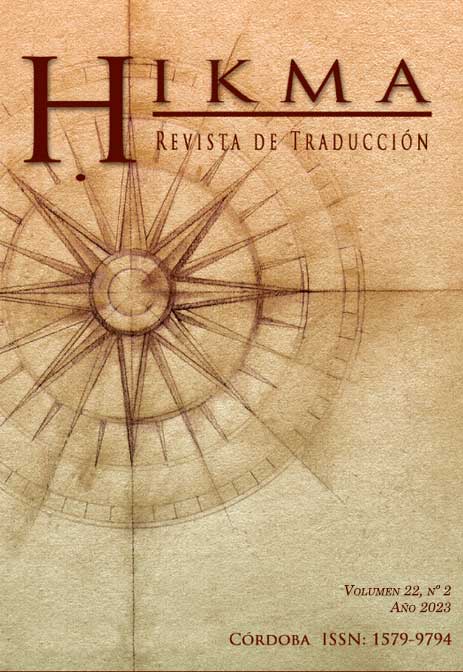Translation study of El cementerio de la aldea (Imitación de Gray) (1859) A sample of incomplete interpretive resemblance
Main Article Content
Abstract
Poetry texts are defined by an ostensive use of the language, which derives into a significant mental effort on the part of the target audience to process a relevant stimulus provided by the writer and that the audience has also considered worthy of their attention. Such mental effort is maximised when desirable information is communicated in an implicit manner by means of the so-called figures of speech. However, this additional effort will without doubt enrich the receptor’s cognitive and aesthetic experience. Based on Relevance Theory, formulated by Dan Sperber and Deirdre Wilson (1986), E. A. Gutt (1989; 2014) suggests a model for translation intended to achieve an incomplete interpretive resemblance, by means of which translators need to solely convey similar adequate and highly relevant contextual assumptions from the original text. Albeit textual properties of the source text may licitly be subjected to certain, sometimes necessary, modifications in this model for translation, the recreation of the source text must be completely avoided. The primary aim of the current paper is to undertake a translation study of four extracts from Elegy written in a country churchyard with respect to El cementerio de la aldea. (Imitación de Gray) (1859), by the 19th century Andalusian translator José Fernández Guerra, as a sample of incomplete interpretive resemblance.
Downloads
Article Details

This work is licensed under a Creative Commons Attribution-NonCommercial-ShareAlike 4.0 International License.
Authors who publish with this journal agree to the following terms:
1. Authors retain copyright and grant the journal right of first publication with the work simultaneously licensed under a Creative Commons Attribution License that allows others to share the work with an acknowledgement of the work's authorship and initial publication in this journal.
2. Authors are able to enter into separate, additional contractual arrangements for the non-exclusive distribution of the journal's published version of the work (e.g., post it to an institutional repository or publish it in a book), with an acknowledgement of its initial publication in this journal.
3. Authors are permitted and encouraged to post their work online (e.g., in institutional repositories or on their website) prior to and during the submission process, as it can lead to productive exchanges, as well as earlier and greater citation of published work (See The Effect of Open Access).
References
Calvillo Reyes, J. C. (2019). Relevancia y traducción literaria. Fundamentos para la propuesta de un modelo analítico. Mutatis Mutandis, 12(2), 454-474. https://doi.org/10.17533/udea.mut.v12n2a06 DOI: https://doi.org/10.17533/udea.mut.v12n2a06
Candria, M. (2011). The value of relevance theory in literary analysis. Prosiding Seminar Nasional: Membangun Masyarakat Indonesia Dalam Perspektif Budaya (pp. 197-213). http://eprints.undip.ac.id/36628/2/Prosiding_Mytha-value_of_RT_in_literature_analysis.pdf
Cox, S. (1990). Sensibility as argument. En S. McMillen. (Ed.), Sensibility in transformation: creative resistance to sentiment from the Augustans to the Romantics. Essays in honor of Jean H. Hagstrum (pp. 63-82). Fairleigh Dickinson University Press.
Clymer, L. (1995). Graved in tropes: the figural logic of epitaphs and elegies in Blair, Gray, Cowper, and Wordsworth. ELH: A Journal of English Literary History, 62(2), 347-386. https://doi.org/10.1353/elh.1995.0011 DOI: https://doi.org/10.1353/elh.1995.0011
Dahlgren, M. (2005). Preciser that we are: Emily Dickinson’s poems in translation. A study in literary pragmatics. Journal of Pragmatics, 37, 1081-1107. https://doi.org/10.1016/j.pragma.2005.01.011 DOI: https://doi.org/10.1016/j.pragma.2005.01.011
Edwards, T. R. (1971). Imagination and power: a study of poetry on public themes. Chatto & Windus.
Escandell Vidal, M. V. (1994). La noción de «estilo» en la teoría de la relevancia. En E. Dehennin y H. Haverkate (Eds.), Lingüística y estilística de textos (pp. 55-64). Rodopi. DOI: https://doi.org/10.1163/9789004485464_006
Fernández Guerra, J. (1859). El cementerio de la aldea. En Poesías de D. Manuel Cañete, de la Real Academia Española. El Heraldo.
Fundación Gustavo Bueno (1996). Proyecto Filosofía en Español. https://www.filosofia.org/ave/001/a260.htm
Guillory, J. (1993). Cultural capital: the problem of literary canon formation. University of Chicago Press. DOI: https://doi.org/10.7208/chicago/9780226310015.001.0001
Golban, P. (2005). Transitional phenomena in the 18th century English literature. Dumlupınar Üniversitesi Sosyal Bilimler Dergisi, 13, 187-194. https://dergipark.org.tr/en/pub/dpusbe/issue/4755/65322
Gray, T. (1834). Elegy written in a country churchyard. John van Voorst.
Gutt, E. A. (1989). Translation and relevance. UCL Working Papers in Linguistics, 1, 75-95.
Gutt, E. A. (1992). On the nature and treatment of implicit information in literary translation: a relevance-theoretic perspective. International Journal of Translation Studies, 8, 241-256. DOI: https://doi.org/10.1075/target.8.2.03gut
Gutt, E. A. (2014). Translation and relevance: cognition and context. Routledge. DOI: https://doi.org/10.4324/9781315760018
Iliescu Gheorghiu, C. (2005). Traducción y subversión: un modelo de base cognitiva para el análisis traductológico de textos dramáticos. Sendebar, 16, 59-78. https://doi.org/10.30827/sendebar.v16i0.1046
Manlove, C. N. (1978). Literature and reality 1600-1800. Palgrave MacMillan.
Manning, S. (2005). Sensibility. En J. Richetti (Ed.), The Cambridge history of English literature 1660-1780 (pp. 80-99). Cambridge University Press. DOI: https://doi.org/10.1017/CCOL0521809746.005
McKendry, A. (2012). “For thou can’st read”: cultural silence and education in Gray’s «elegy». Lumen, 31, 101-114. https://doi.org/10.7202/1013070ar DOI: https://doi.org/10.7202/1013070ar
Real Academia Española. (2019). Diccionario de la lengua española (22a ed.). http://www.rae.es/rae.html
Smith, K. (2000). Bible translation and relevance theory: the translation of Titus [Tesis doctoral. University of Stellenbosch] https://sats.ac.za/wp-content/uploads/2019/10/BibleTranslationandRelevanceTheory.pdf
Smith, K. (2002). Translation as secondary communication. The Relevance theory perspective of Ernst-August Gutt. Acta Theologica Supplementum, 2, 107-117. https://doi.org/10.4314/actat.v22i1.5456 DOI: https://doi.org/10.4314/actat.v22i1.5456
Spacks, P. M. (2001). The poetry of sensibility. En J. Sitter (Ed.), The Cambridge Companion to eighteenth-century poetry (pp. 249-269). Cambridge University Press. DOI: https://doi.org/10.1017/CCOL0521650909.012
Sperber, D. y Wilson, D. (1986). Relevance: communication and cognition. Blackwell.
Villamor Iglesias, A. (2020). El estudio de la metáfora y la ironía a través de la teoría de la relevancia. Logos: Revista de Lingüística, Filosofía y Literatura, 30(1), 111-118. https://doi.org/10.15443/RL3009 DOI: https://doi.org/10.15443/RL3009
Weinfield, H. (1991). The poet without a name: Gray’s elegy and the problem of history. Southern Illinois University Press.
Williams, J. C. (2018). Thomas Gray's «elegy» and the politics of memorialization. SEL Studies in English Literature 1500-1900, 58, 653-672. https://doi.org/10.1353/sel.2018.0026 DOI: https://doi.org/10.1353/sel.2018.0026
Zhonggang, S. (2006). A relevance theory perspective on translating the implicit information in literary texts. Journal of Translation, 2(2), 43-60. https://doi.org/10.54395/jot-xdhen DOI: https://doi.org/10.54395/jot-xdhen

